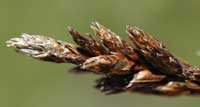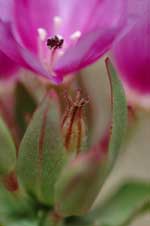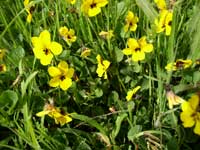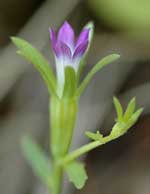A Journey Through the Scott Creek Watershed

 Grasslands
Grasslands
The coastal prairie, an ecological continuum that parallels Highway 1, from the north end of Swanton Road, with its isolated populations of Kellogg's horkelia (Horkelia cuneata var. sericea) and Roemer's fescue (Festuca roemeri) [currently under F. idahoensis in The Jepson Manual, Second Edition] to the California sagebrush (Artemisia californica) margined terrace edge overlooking Scott Creek Marsh proper, hosts a myriad of rare and unusual plant species. This horizontal ribbon of terrain, punctuated with seeps and marshes, is overwhelmingly defined by a triad of monocot families, namely the Cyperaceae, Juncaceae, and Poaceae: the exceedingly rare Blasdale's bent-grass (Agrostis blasdalei) vies for attention with the extremely complex Carex "gianonei/nitidicarpa" quagmire and the extraordinary representation of Juncus species (J. bufonius var. bufonius, J. effusus subsp. pacificus, J. lescurii, J. mexicanus, J. occidentalis, J. patens, and J. phaeocephalus).
sericea) and Roemer's fescue (Festuca roemeri) [currently under F. idahoensis in The Jepson Manual, Second Edition] to the California sagebrush (Artemisia californica) margined terrace edge overlooking Scott Creek Marsh proper, hosts a myriad of rare and unusual plant species. This horizontal ribbon of terrain, punctuated with seeps and marshes, is overwhelmingly defined by a triad of monocot families, namely the Cyperaceae, Juncaceae, and Poaceae: the exceedingly rare Blasdale's bent-grass (Agrostis blasdalei) vies for attention with the extremely complex Carex "gianonei/nitidicarpa" quagmire and the extraordinary representation of Juncus species (J. bufonius var. bufonius, J. effusus subsp. pacificus, J. lescurii, J. mexicanus, J. occidentalis, J. patens, and J. phaeocephalus).
Lost in this vertiginous tapestry of rushes, are lilliputian treasures that demand a measured approach lest they be trampled underfoot: timwort (Cicendia quadrangularis), a member in good standing of the Gentianaceae coyly masquerading to the uninitiated as a member of the Brassicaceae; Gambel's milkvetch (Astragalus gambelianus) comingling with cousins of the Acmispon clan; dwarf club rush (Isolepis carinata) and
 tiny pentachaeta (Pentachaeta alsinoides) (a 25-cent piece could jointly accommodate both species); and sand pygmy-weed (Crassula connata), at maturity displaying foliage pigmented red-orange through pink, coloration that would elicit envy from a Navaho sand-painter!
tiny pentachaeta (Pentachaeta alsinoides) (a 25-cent piece could jointly accommodate both species); and sand pygmy-weed (Crassula connata), at maturity displaying foliage pigmented red-orange through pink, coloration that would elicit envy from a Navaho sand-painter!
Where siliceous terrace deposits prevail, rare Clarkia species, godetia (C. purpurea subsp. purpurea) and the separate-but-equal Davy's clarkia (C. davyi) and what may be prostrate clarkia (C. prostrata) share habitat with the variable, both as to scent and foliar coloration, Franciscan coyote mint (Monardella villosa subsp. franciscana) complex.
Inner Grasslands
The inner coastal grasslands, with their deeply incised forested gulches draining down into Scott Creek, form a mirror-image compliment to the prairie proper, from which they are separated by an east-facing syncline. At its northwest end, is the "Magic Triangle," refuge to 120+ native plant species, with at least two, Franciscan paintbrush (Castilleja subinclusa subsp. franciscana) and celery-leaved licorice-root (Ligusticum apiifolium), found nowhere else in the county.
Twenty-five years ago, while documenting this microcosm of species diversity, I chanced upon flowering specimens of Castilleja subinclusa subspecies franciscana and crimson columbine (Aquilegia formosa) growing side by side and both being pollinated by hummingbirds, a fascinating lesson in co-evolution! To this, add the presence of Bigelow's microseris (Microseris bigelovii) and silverpuffs (Uropappus lindleyi) at opposite edges of this relatively small near-vertical habitat, with their allotetraploid offspring Santa Cruz microseris (Stebbinsoseris decipiens) in between, and you have a living laboratory to study species formation.
 Heading in a southerly direction along the grass-cloaked syncline, one encounters a nonet of native Trifoliums (T. barbigerum, T. depauperatum, T. gracilentum, T. macraei, T. microcephalum, T. microdon, T. rostratum [not currently recognized, but placed under T. variegatum var. major in The Jepson Manual], T. variegatum, and T. willdenovii). This constellation of clover species shares habitat with owl's-clover (Castilleja densiflora subsp. densiflora), in its distinctive vanilla-scented noctuinus phase); caraway-leaved lomatium (Lomatium caruifolium var. caruifolium), with highly variable foliage ranging from glabrous through densely pubescent; Johnny jump-up (Viola pedunculata), with a subterranean stem/root system that would seem commensurate with an adult oak rather than an herbaceous perennial ca. 10-20 cm in height; sky lupine (Lupinus nanus), exhibiting flowers ranging in color from white fading tan, through pink, lavender, pale-blue, and finally the traditional dark-blue; and footsteps-of-spring (Sanicula arctopoides), with radially aligned, prostrate, yellow-green foliage looking like a surreal sun-dial.
Heading in a southerly direction along the grass-cloaked syncline, one encounters a nonet of native Trifoliums (T. barbigerum, T. depauperatum, T. gracilentum, T. macraei, T. microcephalum, T. microdon, T. rostratum [not currently recognized, but placed under T. variegatum var. major in The Jepson Manual], T. variegatum, and T. willdenovii). This constellation of clover species shares habitat with owl's-clover (Castilleja densiflora subsp. densiflora), in its distinctive vanilla-scented noctuinus phase); caraway-leaved lomatium (Lomatium caruifolium var. caruifolium), with highly variable foliage ranging from glabrous through densely pubescent; Johnny jump-up (Viola pedunculata), with a subterranean stem/root system that would seem commensurate with an adult oak rather than an herbaceous perennial ca. 10-20 cm in height; sky lupine (Lupinus nanus), exhibiting flowers ranging in color from white fading tan, through pink, lavender, pale-blue, and finally the traditional dark-blue; and footsteps-of-spring (Sanicula arctopoides), with radially aligned, prostrate, yellow-green foliage looking like a surreal sun-dial.
Rare species and hybrid complexes abound within and peripheral to this faux-prairie: in the monocot side
 of the aisle, documented interspecific crosses occur between Blasdale's bent-grass (Agrostis blasdalei) and spike bent grass (Agrostis exarata); common rush (Juncus patens) and bog rush (Juncus hesperius); and at least three sections of the genus Carex (Montanae, Multiflorae, and Ovales).
of the aisle, documented interspecific crosses occur between Blasdale's bent-grass (Agrostis blasdalei) and spike bent grass (Agrostis exarata); common rush (Juncus patens) and bog rush (Juncus hesperius); and at least three sections of the genus Carex (Montanae, Multiflorae, and Ovales).
Giving the dicots equal time, with less emphasis on sex and more on species diversity, a potentially new species of Nemophila (aff. N. pulchella var. fremontii) shares growing space with the silk tassel bush (Garrya elliptica), common bluecup (Githopsis specularioides), Santa Cruz clover (Trifolium buckwestiorum); a trio of borages [bent-flowered fiddleneck (Amsinckia lunaris), dwarf cryptantha (Cryptantha torreyana var. pumila), and Pacific hound's-tongue (Cynoglossum grande)]; oceanspray (Holodiscus discolor var. discolor); California fescue (Festuca californica); and its common sister species small-flowered nemophila (Nemophila parviflora var. parviflora) (the two species often are found growing intertwined in the same habitat).
pumila), and Pacific hound's-tongue (Cynoglossum grande)]; oceanspray (Holodiscus discolor var. discolor); California fescue (Festuca californica); and its common sister species small-flowered nemophila (Nemophila parviflora var. parviflora) (the two species often are found growing intertwined in the same habitat).
Lastly, within this parallel prairie, a species for years thought to be extinct, the rare San Francisco popcornflower (Plagiobothrys diffusus) creates isolated tapestries of miniature white-and-yellow flowers on prostrate plants referenced millimeters above a thin skin composed of grass and moss, which covers the exposed geometry of the fractured coastal terraces.
All photographs © Dylan Neubauer